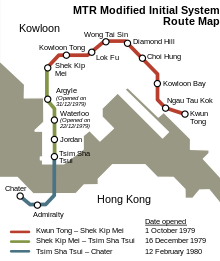Modified Initial System

The Modified Initial System refers to the railway project and the first line of the Mass Transit Railway (MTR) which ran between Kwun Tong station in New Kowloon and Chater station (the eastern part of Central station since 1985) in Victoria City on Hong Kong Island. It was the first rapid transit rail line in the territory.
History
In early 1975, the Mass Transit Steering Group was replaced by the Mass Transport Provisional Authority, which held more executive powers.[1] It announced that the Initial System would be reduced to 15.6 kilometres (9.7 mi) and renamed the "Modified Initial System". Plans for a single contract were abandoned in favour of 25 engineering contracts and 10 electrical and mechanical contracts. On 7 May 1975 the Legislative Council of the territory passed legislation setting up the government-owned Mass Transit Railway Corporation (MTRC) to replace the Mass Transport Provisional Authority.[2][3]
Construction of the Modified Initial System (now part of the Kwun Tong line and Tsuen Wan line combined) commenced in November 1975. The northern section was completed on 30 September 1979 and was opened on 1 October 1979 by Governor Murray MacLehose.[4] Trains on this route ran from Kwun Tong to Shek Kip Mei in Phase 1, entirely within New Kowloon, from there to Tsim Sha Tsui in Phase 2, extending through Kowloon beneath Nathan Road, and to Chater the last phase, reaching the City of Victoria across the harbour with two stations, initially in a four-car configuration. The section between Kwun Tong and the midpoint of Choi Hung and Kowloon Bay stations runs on viaducts, and the rest mostly in cut-and-cover tunnels, except for short sections underneath hills such as Bishop Hill near Shek Kip Mei, as well as the tunnel beneath Victoria Harbour.
During its constructions many roads were closed, for example, Chater Road and the entire length of Nathan Road in several stages. The former Supreme Court Building, which later became the home of the territory Legislative Council and now the Court of Final Appeal, had to be reinforced and only the façade is a declared monument. The former General Post Office was demolished and World Wide House was built in its place, atop the Chater and Pedder stations beneath it.
The first train drivers were trained on the London Underground.[4] The route from Tsim Sha Tsui station to Shek Kip Mei station opened in December 1979.[5]
The full Modified Initial System was opened on 12 February 1980 by Princess Alexandra, who rode the inaugural train through the immersed tube beneath Victoria Harbour to Chater station, since renamed Central station.[6] Trains were gradually extended to six cars to accommodate an increase in passenger numbers.
Design and construction
It was designed by a consortium of consultants led by Freeman Fox and Partners. On later extensions to the railway the stations were designed under the supervision of Roland Paoletti, the chief architect at MTR.[7]
Harbour Crossing Tunnel
It has been suggested that this section be split out into another article titled Harbour Crossing Tunnel. (Discuss) (September 2021) |
You can help expand this article with text translated from the corresponding article in Chinese (Taiwan). (September 2021) Click [show] for important translation instructions.
|
This section needs expansion. You can help by adding to it. (September 2021) |
Between Tsim Sha Tsui and Admiralty is the Harbour Crossing Tunnel, a 1.4-kilometre (1,500 yd) reinforced concrete immersed tube tunnel across Victoria Harbour which construction commenced in 1976. Its deepest point is at 24.24 m (79.5 ft). The binocular sections were constructed in Chai Wan.[8][9][10] It was the first railway tunnel to cross the Victoria Harbour and also the first subsea railway tunnel in the territory.
Later development
In preparation for the opening of the Tsuen Wan line in May 1982, trains began operating in two sections in April 1982, between Kwun Tong and Waterloo (Yau Ma Tei) stations, and between Chater and Argyle (Mong Kok) stations respectively. The former would become the Kwun Tong line and labelled green on system maps, and the latter became part of the Tsuen Wan line upon its opening, labelled red. Prince Edward station was added to the north of Argyle station.
See also
References
- ^ "Executive powers for tube Authority". South China Morning Post. 9 February 1974. p. 7.
- ^ "Mass transit: 'Ayes' have it". South China Morning Post. 8 May 1975. p. 1.
- ^ "Tube: the last legal hurdle is removed". South China Morning Post. 8 May 1975. p. 4.
- ^ a b "Mass transit railway is all set to roll". South China Morning Post. 24 September 1979. p. 18.
- ^ "The History". Hong Kong Mass Transit InfoCenter. 27 October 2003. Archived from the original on 7 October 2007. Retrieved 8 March 2007.
- ^ Annual Report 1979. Hong Kong: Mass Transit Railway Corporation. 1980.
- ^ "Hong Kong – A city on the move". Royal Institute of British Architects. Archived from the original on 24 February 2008. Retrieved 12 October 2007.
- ^ http://web.archive.org/web/20170516225441/psdas.gov.hk/content/doc/2007-1-02/Seminar1_04%20-%202007-1-02.pdf
- ^ https://www.scribd.com/document/264532945/Seminar1-04-paper-2007-1-02 https://www.academia.edu/32351466/THE_STATE-OF-ART_TECHNOLOGY_FOR_IMMERSED_TUBE_TUNNEL_IN_HONG_KONG_AND_KOERA
- ^ https://www.checkerboardhill.com/2017/05/underwater-tunnels-mass-transit-railway-hong-hong/
